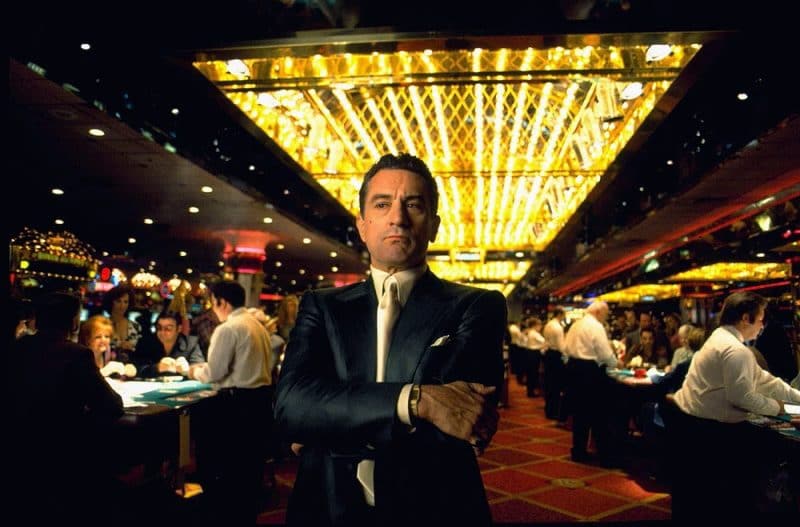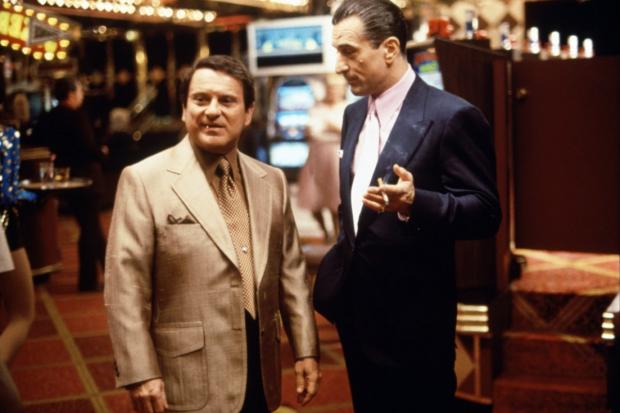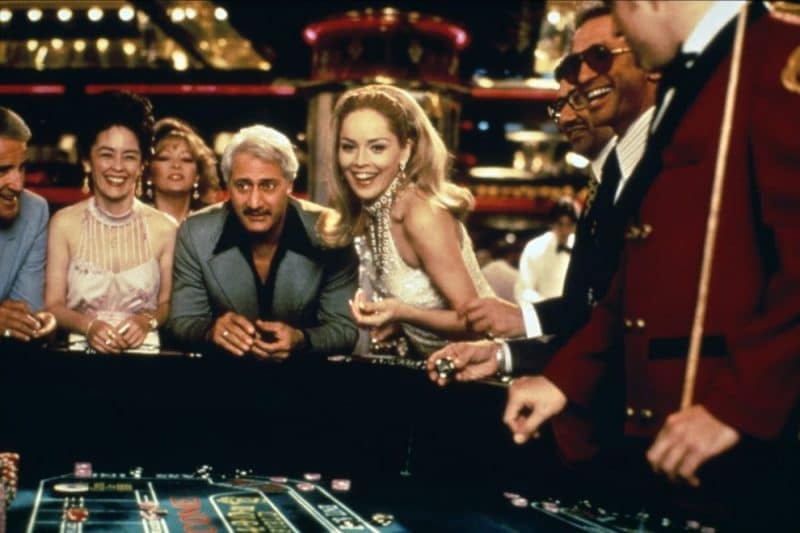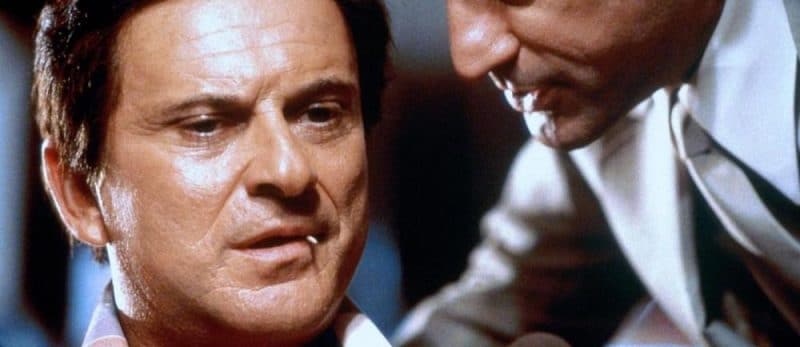18+ | Commercial Content | T&Cs apply | BeGambleAware.org

Martin Scorsese’s movie Casino, is a captivating and vivid piece of entertainment that has become famous for its raw depiction of the mob’s dominance in Las Vegas during the 1970s80s. Although pieces of the movie have seen both positive and some negative reviews, the overall appeal of Scorsese’s entertainment style cannot be denied. The underlying themes of greed and violence are not particularly new, however, Scorsese’s unique entertainment flair has been somewhat refined from GoodFellas and similar gangster movies of the time. Casino is absolutely stunning and captivating as we see all of Scorsese’s entertainment specialities on display.
The Casino as a metaphor of making virtuous life decisions
Contents
To begin with, in his return to the theme of greed and risk, Scorsese uses the intricacy of the casino industry as a metaphor for the complexity of making virtuous life decisions, and the downfall that can occur through misjudgement or a lack of self-control. Each of the main characters in the movie see an eventual fallout of their status, power, and reputation, as the relentless desire for more trumps self-control and calculated risk taking. This metaphoric depiction Scorsese creates of the self-serving human nature is unprecedented in his time. Yet, in his depiction of overwhelming greed, Scorsese does not tarnish the entertainment appeal of the casino, instead showing a deep appreciation for the gambling industry by highlighting the thoughtfulness required to master the game. For example, when Ace notices one woman hiding cards in her purse, and in another instance, two men are attempting to cheat by signalling cards to one another, Scorsese makes an art out of revealing the cheaters, showing the calculated and intentional actions that are necessary to outsmart the game. In these scenes, Scorsese captures the audience in the slow and building intensity of the discovery of cheating, spreading the word among the casino’s employees, and eventually eliminating the players. This captivating unravelling speaks to Scorsese’s unique ability to let his story unfold through intentional scenes and techniques.
For example, when Ace notices one woman hiding cards in her purse, and in another instance, two men are attempting to cheat by signalling cards to one another, Scorsese makes an art out of revealing the cheaters, showing the calculated and intentional actions that are necessary to outsmart the game. In these scenes, Scorsese captures the audience in the slow and building intensity of the discovery of cheating, spreading the word among the casino’s employees, and eventually eliminating the players. This captivating unravelling speaks to Scorsese’s unique ability to let his story unfold through intentional scenes and techniques.
Scorsese’s storytelling techniques are one significant way his entertainment style in Casino is particularly set apart from prior movies. Commonly used in his movies are scene freezes, voice overs, slow motion, and flashbacks to the characters’ memories. These techniques add dimension to the movie and cause the viewer to pause with the story, absorbing all the pieces as they come together, instead of passively observing. In pure artistic talent, Scorsese uses vivid shots in Casino of both glitz and darkness, adding imagery to the underlying themes. The story itself spans over about a decade, and the film’s ability to expand the scope of the imagery across the developing Las Vegas horizon is brilliant. From the classy casino shots to the dirty back alleys and the simplistic deli shop back home, Scorsese emphasizes the sharp contrast between the attractive draw of Vegas, and the dullness of everything else compared to it. The scenes inside the casino are thick with glamour and appeal for the potential wealth they represent to the players if they are willing to take the risk.
In stark contrast, the graphic, violent scenes represent the costs to this risk if it is not well calculated or executed. Often critiqued for being overly violent, Casino takes a bold new stance in entertainment, not shying away from scenes of vivid, almost uncomfortable violence. Scorsese is clearly not afraid to take risks in this movie to depict the realistic intensity of the mob and their no-nonsense approach to ruling the evolving Las Vegas strip.

Additionally, Scorsese’s ability to interlace individual character’s stories, for example Nicky’s uncharacteristic tenderness with his son, with the main story of the movie is captivating and keeps the viewer wanting more. In certain instances, we see the characters faced with flashbacks of their past, visualizing their internal struggles to pick a side or a make a decision. Moreover, Scorsese begins the movie with a piece from the end of the story, creating a dramatic appeal and curiosity for the viewer. Our interests are sparked with a snapshot of the end of the story, and we are drawn into the film, wondering how our in-control Ace is going to end up victim to a car explosion. As a whole, Scorsese’s storytelling abilities are complex, revealing just enough at just the right time to keep you engaged and invested in the story.
This technique is complemented by the switching narration from Nicky to Sam, creating a unique robustness to the movie. Scorsese provides further depth to the depiction of greed, as well as the characters themselves, by allowing viewers to hear the characters’ individual perspectives and thoughts in different scenes. In particular moments we get to hear and see both Nicky’s viewpoint on an event, as well as Sam’s usually contrasting side. This stylistic effect makes you feel inside the story, learning the intricacies of the mob network and the insider secrets of the widespread corruption. As he introduces characters and their motives through this narration, Scorsese effectively generates a certain appeal and draw to each of the character’s personalities as individuals. In this sense, Scorsese is able to create a more complete story and a build appeal to the characters as their narration adds another dimension to the actual acting.
A painting of greed, violence and corruption
In respect to the character development, Nicky’s and Sam’s personas have often been critiqued as unoriginal, while Ginger is widely praised for her great performance. While the actors may be similar to previous films, the newness of entertainment comes from the matchless dynamics and interactions between the characters. Scorsese’s play writing does an especially excellent job at expanding the scope of the movie by allowing the characters’ personalities evolve as the movie progresses. For example, Sam Rothstein depicts the more thought-out, business-minded leader of the mob’s operations, the calculative aspect of gambling and running the casino. He presents a calm, yet complex demeanour at the beginning of the movie, yet we see the corruption overtake him with an unsettling, constant need for more. This is brilliantly juxtaposed with Nicky’s enforcer attitude, demanding attention through his brute force attitude. From our first introduction to Nicky, we get a sense of his in-your-face presence and unrelenting drive for money and power. While Sam attempts to coach Nicky as he enters the Vegas scene, the two personalities clash repeatedly creating captivating confrontations. These two characters on the surface may not seem inherently unique,
For example, Sam Rothstein depicts the more thought-out, business-minded leader of the mob’s operations, the calculative aspect of gambling and running the casino. He presents a calm, yet complex demeanour at the beginning of the movie, yet we see the corruption overtake him with an unsettling, constant need for more. This is brilliantly juxtaposed with Nicky’s enforcer attitude, demanding attention through his brute force attitude. From our first introduction to Nicky, we get a sense of his in-your-face presence and unrelenting drive for money and power. While Sam attempts to coach Nicky as he enters the Vegas scene, the two personalities clash repeatedly creating captivating confrontations. These two characters on the surface may not seem inherently unique, however their scenes together display an unprecedented, entertaining interaction. In one particular scene when the Sam throws the disrespectful man in the cowboy hat out of his casino and ends up getting a call from Nicky, we see a face-off between the two personalities. As Sam tries to maintain firm and level headed through Nicky’s yelling and abuse of his guy, Scorsese subtly draws out the delicate balance between fighting until you win and knowing when to walk away from the table.
In one particular scene when the Sam throws the disrespectful man in the cowboy hat out of his casino and ends up getting a call from Nicky, we see a face-off between the two personalities. As Sam tries to maintain firm and level headed through Nicky’s yelling and abuse of his guy, Scorsese subtly draws out the delicate balance between fighting until you win and knowing when to walk away from the table.

Additionally, the interactions between Sam and Ginger must be noted for their own matchless entertainment value. The build-up and then unravelling of Ginger’s character adds an irreplaceable pull on the viewer’s emotions. Her poise and innate ability to wear her poker face at the beginning of the movie is captivating, for both the viewers and her future husband. Interestingly, we never get a chance to hear narrative perspective, adding to the mystery of her persona and a curiosity to her motivations. Nevertheless, we see the underlying theme of greed is not lost on her either, as her marriage begins and remains founded on her desire for material abundance. Satisfied only with expensive things and money, Ginger’s realistic embodiment of the inability to love and be loved by another human adds to the depiction of corruption of a human soul by unfulfilled desire. The only time we see Ginger’s self-indulgence wavier is in her devotion to her former pimp as she painstakingly continues to give her money to him. Nonetheless, her inability to maintain self-control over her emotions and greed, combined with Sam’s attempt to domesticate her, eventually push Ginger to a breaking point. She unravels completely ungracefully, culminating into a catastrophic standoff with Sam outside their house. These fights are captivating at their core, as Scorsese uses the natural human tendency for intimacy as another depiction of self-indulgence. Sam’s once genuine love for Ginger spirals into a need to control and find receptivity for his love. However, he never does quite find this refuge, and the dramatic fights that result are unparalleled. The abuse of the relationship is so graphic it makes you cringe in certain scenes, yet the tension that Scorsese is able to convey between these bold personalities is highly appreciable and adds yet another level of
Nevertheless, we see the underlying theme of greed is not lost on her either, as her marriage begins and remains founded on her desire for material abundance. Satisfied only with expensive things and money, Ginger’s realistic embodiment of the inability to love and be loved by another human adds to the depiction of corruption of a human soul by unfulfilled desire. The only time we see Ginger’s self-indulgence wavier is in her devotion to her former pimp as she painstakingly continues to give her money to him. Nonetheless, her inability to maintain self-control over her emotions and greed, combined with Sam’s attempt to domesticate her, eventually push Ginger to a breaking point. She unravels completely ungracefully, culminating into a catastrophic standoff with Sam outside their house. These fights are captivating at their core, as Scorsese uses the natural human tendency for intimacy as another depiction of self-indulgence. Sam’s once genuine love for Ginger spirals into a need to control and find receptivity for his love. However, he never does quite find this refuge, and the dramatic fights that result are unparalleled. The abuse of the relationship is so graphic it makes you cringe in certain scenes, yet the tension that Scorsese is able to convey between these bold personalities is highly appreciable and adds yet another level of
Nonetheless, her inability to maintain self-control over her emotions and greed, combined with Sam’s attempt to domesticate her, eventually push Ginger to a breaking point. She unravels completely ungracefully, culminating into a catastrophic standoff with Sam outside their house. These fights are captivating at their core, as Scorsese uses the natural human tendency for intimacy as another depiction of self-indulgence. Sam’s once genuine love for Ginger spirals into a need to control and find receptivity for his love. However, he never does quite find this refuge, and the dramatic fights that result are unparalleled. The abuse of the relationship is so graphic it makes you cringe in certain scenes, yet the tension that Scorsese is able to convey between these bold personalities is highly appreciable and adds yet another level of draw to the individual characters themselves. At the conclusion of the movie when we see Ginger overdose in the hallway of a dirty motel, Scorsese has already drawn you in enough to feel the weight of her self-destruction and leave you wishing more for her.
Complementary to these three dominant personalities, Scorsese entertainingly draws out the whole network that upholds the mob’s presence over Las Vegas and the widespread corruption that is laced within it. We get a glimpse into the politicians, the union, law enforcement, and different roles within the mob itself. The network of the mob is particularly well drawn out in scenes where we see money tracked from the players in the casino, to the back room, and all the way to the top guys, far removed from the actual casino itself. Scorsese does an excellent job at revealing the different players on the Vegas scene as the movie progresses, while doing justice to the historic accuracy. In this storytelling, he is able to show the widespread infiltration of the mob and its explicit reliance on loyalty to hold all the pieces together.
The interconnectedness of different people in the network plays out when Sam fires the nephew of a prominent figure and refuses to rehire him, even when he is pressured by yet another piece of the corrupted network. Sam’s eventual fallout from this one event shows how delicately all the players are layered together; how dependent one’s success can be on their personal network. This effect is emphasized further as the FBI eventually infiltrates the mob’s network through unexpected entry points like eavesdropping on conversations between one of the bosses and his mother, which becomes enough to spiral into a crumbling of the whole network. Nonetheless, the emphasis of loyalty does not diminish as Nicky is eventually buried alive as a result of his betrayal to the values of mob, sleeping with Sam’s wife.

This is perhaps one of Scorsese’s major strengths; his ability to layer multiple themes and ideas into his movies. In the midst of an unwavering greed for money and power driving the story, there is foundational essence of loyalty. For instance, although all of Nicky’s actions are motivated by his hunger for money, and with Ginger, self-indulgence in general, he also struggles to some degree with his supposed loyalty to Sam. In the end when Ginger comes to him enraged and demanding that Nicky kill Sam, he shows his inability to turn that far on his fellow partner and throws her out instead.
The dramatic breakdown of Ginger and Nicky’s brutal expulsion of her from his place, compellingly captures the uncontrolled emotions and thoughts that are depicted as the root of all breakdowns in this movie. Again, Scorsese plays with different channels to convey the underlying themes of his movie. He is moving in the tension he cultivates between Nicky, Sam, and Ginger throughout the affair, and we are overcome with a sense of betrayal. The initial fundamental need for trust in Sam and Ginger’s relationship is painstakingly lost, despite his insistence for her loyalty. Throughout the movie, Sam repeatedly emphasizes to Ginger how important it is for him to be able to trust her, even if there is no love. Yet in the end we are moved by the dramatic betrayal that subtly builds and eventually comes crushing down on everyone. Scorsese does not miss the opportunity to connect with the viewers on natural human tendencies and creatively adds a dimension of loyalty to the story of organized crime.
Understanding of the art of gambling
As a whole, Scorsese shows a deep appreciation and understanding of the art of gambling in Casino. His metaphoric use of the casino network to depict the risks of life and the importance of maintaining self-control, speaks to his matchless ability to layer meaning in a classic crime and mob movie.
The captivating entertaining appeal of the film comes from Scorsese’s unprecedented ability to create flashy, in-your-face scenes without comprising the integrity of the story. Although his use of scene freezes, slow motion, narrative expression, and tracking shots are not explicitly exclusive to Casino, Scorsese is distinct in his ability to create just the perfect combination of these techniques to draw you into the story.
Each scene feels like it is there for a purpose; building intensity, adding perspective, or for pure entertainment value. He knows just when to throw in a violent scene, and when to pull back and let the story speak for itself. The intentional unraveling of this mob story is mystic and demanding of all your attention. Behind the explicitly violent scenes and widespread profanity, Scorsese does not fail to show his artistic intelligence, appealing to all types of viewers.
Rebecca Kong, winner of the De Niro Scholarship.
After this analysis, you would probably like the best scenes from Casino:
